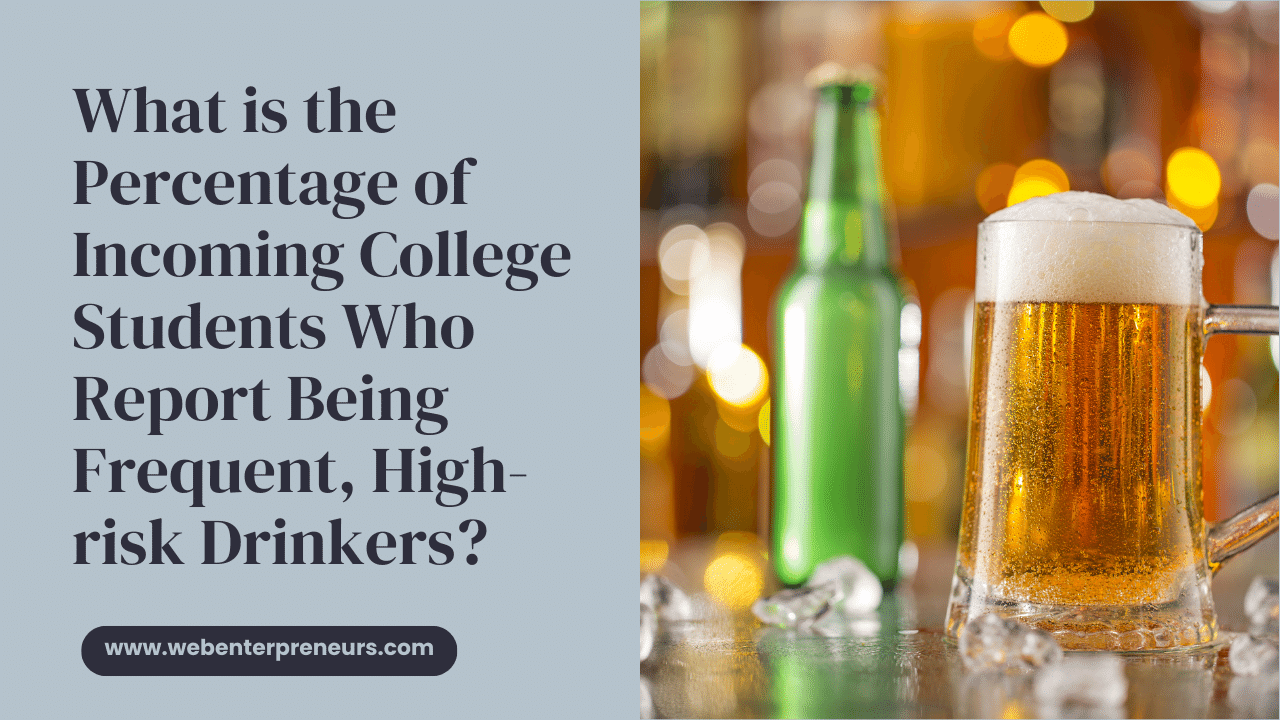From the excitement of newfound independence to the pressures of academic life, college presents a unique set of challenges and opportunities. One of the widely acknowledged aspects of the college experience, for better or worse, is alcohol consumption. Our focus in this piece is an exploration of high-risk drinking behavior among incoming college students. As experts in the field of public health and college student behavior, we’ll delve into the statistics, factors influencing “What is the Percentage of Incoming College Students Who Report Being Frequent, High-risk Drinkers?”.
How Prevalent is High-Risk Drinking Among Incoming College Students?

One of the most pressing questions we encounter is the actual percentage of college freshmen who engage in high-risk drinking. According to the National Institute on Alcohol Abuse and Alcoholism (NIAAA), approximately 40% of college students reported engaging in binge drinking, a form of high-risk drinking, in the last month. When we narrow the demographic to incoming college students, this percentage varies but still poses a significant concern.
Does Alcohol Consumption Affect Academic Performance?

Studies have shown that there is a connection between alcohol consumption and academic performance. Students who engage in high-risk drinking are more likely to face academic issues, including lower grades and higher dropout rates. This detrimental impact prompts us to investigate the factors contributing to high-risk drinking behaviors among incoming college students.
What Factors Contribute to High-Risk Drinking Behaviors?

The transition to college life is a significant period marked by various influences on drinking behaviors. Peer pressure, stress from academic life, curiosity, and the allure of social drinking scenes all contribute to alcohol consumption. However, it’s important to note that these factors do not justify or normalize high-risk drinking behavior. Rather, they provide a basis for understanding why it occurs and how to counteract it.
Are There Preventive Measures in Place?
Numerous universities across the nation have implemented preventive measures to curb high-risk drinking. These initiatives range from strict enforcement of alcohol policies and offering alcohol-free activities to providing education about alcohol-related harms. Campus-wide interventions involving peer educators also show promise in reducing high-risk drinking behaviors.
Note: While these measures can help, it’s crucial for students to maintain a sense of personal responsibility in their alcohol consumption habits.
How to Promote Responsible Drinking?

To curb high-risk drinking among college students, a multi-pronged approach is necessary. Promoting responsible drinking involves creating a campus environment that supports sober activities, fostering an understanding of the effects of high-risk drinking, and encouraging students to look out for each other. It’s about changing the narrative around alcohol consumption from one of excess to one of moderation and safety.
Remember, the college experience is meant to be an enriching journey of academic and personal growth. Don’t let high-risk drinking behaviors overshadow this opportunity. Let’s promote responsible drinking, ensure safety, and prioritize well-being as key aspects of the college experience. Stay informed, stay safe, and make the most out of your college journey!
A Deeper Look at the Alcohol Culture in College
The college experience is often associated with new freedoms and experiences, many of which involve alcohol. It’s not uncommon to hear stories about fraternity parties or Wednesday night bar hops. While these activities might seem like harmless fun, they often lead to high-risk drinking behaviors, especially among incoming college students.
The Power of Peer Influence
One of the significant contributors to alcohol consumption among college students is peer influence. As many young adults strive to fit in and make new friends, they may feel pressured to drink alcohol, often more than they can handle. According to a study by Borsari and Carey (2001), students’ perceptions of their peers’ drinking habits are a substantial determinant of their own drinking behavior. Misconceptions that ‘everyone drinks’ or ‘drinking is a rite of passage in college’ often lead to excessive alcohol consumption.
Stress and Alcohol: A Troubling Connection
Another contributing factor to high-risk drinking among college students is stress. Transitioning from high school to college can be overwhelming. Many students juggle coursework, part-time jobs, and social obligations, creating a stressful environment. In such situations, some students might resort to alcohol as a stress coping mechanism. However, this form of self-medication can lead to reliance on alcohol and exacerbate stress in the long run.
The Role of Fraternities and Sororities
Greek life on college campuses often plays a significant role in alcohol culture. Parties thrown by fraternities and sororities often involve alcohol, and they might even encourage binge drinking. A study in the Journal of Studies on Alcohol and Drugs found that Greek-affiliated college students are more likely to engage in binge drinking than their non-Greek peers.
Promoting a Healthy College Experience
Addressing the issue of high-risk drinking requires a holistic approach, involving education, prevention measures, and support systems. Here are some ways to promote a healthy college experience:
1. Alcohol Education: Increasing students’ knowledge about the risks and consequences of high-risk drinking can help them make more informed decisions. Many colleges provide alcohol education programs to incoming students, highlighting the impacts of alcohol on physical and mental health, as well as academic performance.
2. Prevention Programs: These programs aim to reduce high-risk drinking by promoting healthier alternatives and strategies to handle peer pressure. They also strive to correct misconceptions about the ‘norms’ of college drinking.
3. Counseling and Support: For students who may be struggling with alcohol abuse, counseling services and support groups can provide much-needed help. These services provide a safe space for students to discuss their concerns and find strategies to overcome their challenges.
The Bottom Line
While alcohol may be a common aspect of the college experience, high-risk drinking does not have to be. With the right knowledge and resources, students can navigate their college years with health and safety in mind. Let’s redefine the college experience to be about growth, learning, and healthy habits.
FAQ About What is the Percentage of Incoming College Students Who Report Being Frequent, High-risk Drinkers?
1. What steps can parents take to prevent high-risk drinking in their college-going children?
Parents can have open discussions about alcohol use, set clear expectations, and promote healthy coping mechanisms for stress. Staying involved and maintaining open lines of communication can also help.
2. How can college students resist peer pressure to engage in high-risk drinking?
Students can practice assertiveness, make their own limits clear, suggest alternative activities, or choose to spend time with friends who respect their decisions about alcohol.
3. What laws are there regarding alcohol consumption on college campuses?
Laws vary by state and by institution, but many campuses enforce minimum legal drinking age laws, and have additional policies on alcohol use on campus. Violations can result in disciplinary action.
Remember, college is about personal growth, forming lifelong friendships, and expanding knowledge. Don’t let high-risk drinking overshadow these precious years. Stay informed, make responsible choices, and ensure your college years are memorable for all the right reasons.
Also Read: Cold Island Breeding Chart (Cold Island) 2023
Conclusion
In conclusion, the prevalence of high-risk drinking among incoming college students is a concern that requires attention from students, parents, and educational institutions alike. Through understanding the factors contributing to these behaviors and implementing effective preventive measures, we can work towards a safer and healthier college environment. We this guide help you in completely understand the most discussed topic “What is the Percentage of Incoming College Students Who Report Being Frequent, High-risk Drinkers?”.

Isabel Lancaster, is a captivating blogger and talented writer. With her enchanting prose and insightful musings, she weaves stories that transport readers to enchanting worlds. Immerse yourself in her captivating tales and embark on a literary journey like no other.

